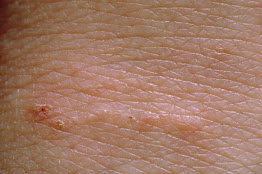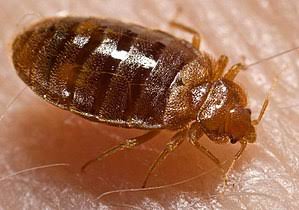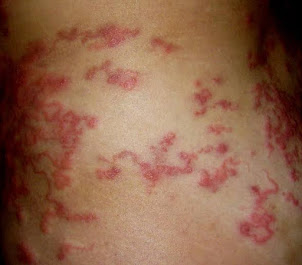Pharmacotherapy/Treatment Of Parasitic Skin Infection
Parasitic skin infections are skin conditions caused by one or more parasites. They are multicellular organisms. They affect people of all ages and can affect one or more skin layers. In worse situations, they enter the bloodstream.
The skin is the largest organ in the body. It is also the first line of defence against infection. The skin is made up of layers. They all have different functions.
The epidermis is the first layer of the skin outside. It protects the body against different forms of parasites from the surrounding. The dermis is the next layer which provides nutrition for the epidermis. The subcutaneous tissue is the last layer which acts as a shock absorber for the skin, stores energy and regulates body temperature.
Causes Of Skin Infection
There are no parasites in the air but in the environment. There are no parasites on the skin. However, the skin is safe as long as the skin is not broken. Parasites can enter the skin from cuts or when there are allergic skin diseases such as eczema.
Read Also: Viral skin infection treatment
A parasite that gains access into the skin will do well to migrate to the layer with the best condition and start to reproduce by laying eggs. This multiplication results in an increased need for more nutrients from under the skin and more space. This leads to different types of skin condition.
Not all parasites invade the skin. Some attack from outside the skin. They need a host to feed on. Some of them can cause symptoms that are significant.
Parasitic Skin Infection
There are thousands of species of parasites that can cause skin infections. Some can cause more than one type of infection. But it is easy to diagnose a parasitic skin infection from other types of skin infection.
Parasitic skin infection often presents with small or large blisters coupled with severe itching. They are common in developing countries. They can appear as lines under the skin. Some are even visible to the naked eyes.
Treatment often consists of topical cream, spray, lotion or ointments. Severe cases rarely occur. Oral medications may be needed sometimes. For parasitic infections that result from bites, killing the parasite with pesticides may work.
Some parasitic infections aren’t contagious, and these infections are typically non-life-threatening.
Diagnosis/Test
Parasitic skin infection can be diagnosed by merely doing skin examination. The room should be well lit and without shadow. The area of the body uncovered and the skin examined with a magnifying len.
Last resort is to request for a laboratory diagnosis. Microscopic examination of the skin can reveal the presence of the parasite or its eggs. Most parasitic skin infections can be diagnosed without it.
Types Of Parasitic Skin Infection
Parasitic skin infections are heterogeneous infections in which parasites are confined to the skin of the host. There are different parasites that cause skin infections. They are classified under four categories. They are:
Pediculosis (Head, Body And Pubic Lice)
Lice is blood sucking small wingless insects. They live in the hair of the hair, pubic and body. They feed on blood of the scalp. They are visible to the eyes because they are of the same size with sesame seeds. Their nits (eggs) is about the size of a small flake of dandruff.
 |
| Head lice |
Symptoms
Scalp and body itching, insect like movement (crawling) on the scalp and body and sores from scratching the area.
Cause
Lice are transmitted from an infected person to another through direct contact. Other methods include sharing of comb, fabrics and other personal belongings. Children are more at risk of lice infection due to the fact that they play together alot.
Diagnosis
Observation of the scalp, body or pubic for lice or its nits. Another method is combing the hair vigorously using a fine toothed lice comb to scratch out the lice onto clear white paper or any other reliable surface.
The adult lice are dark coloured. Newly hatched lice are light in color. Adult lice are easier to find unlike the nits that get cemented to the hair. To make the nits fall off easily, olive oil or any other suitable oil can be added to the hair. It is highly contagious.
Pharmacotherapy/Treatment Of Pediculosis
Pesticides are the best treatment for lice. Pyrethrin from chrysanthemum flowers can be applied on the affected area. It is suitable for children above 2 years of age.
Another alternative is permethrin which is a synthetic pesticide. This one is suitable for children as from two months of age and above.
Benzyl alcohol lotion is the most common and cheap alternative that works pretty well for lice. It is an aromatic alcohol and suitable for children from six months of age.
Melathion is an organophosphate pesticide that is suitable for children six years and older. This malathion is contraindicated in pregnancy and breastfeeding mothers. It is highly flammable.
When all others fail, switch over to lindane, an organochloride lotion or shampoo. It has serious side effects like seizures and death. So care should be taken when administration of this treatment option.
Treating lice requires just one medication approach. There is no need to use two methods. Treatment has to be done two times. The first application is to kill off adult lice. Second application is to kill off nits that have hatched after the first application. To allow the nits to hatch, an average of nine days should be given between the first application and the second.
To prevent lice, wash clothes with hot (54°c or above) soapy water. Dry clothes using heat and disinfect personal belongings such as combs at 54°c for 10 minute. Lice don't survive for more than a couple of days outside their host.
Scabies
This is a very common skin infection caused by a mite known as the sarcoptes seabiei. They are tiny eight leg mites. They live on the skin but burrow in to lay their eggs. It affects more than 130 million people worldwide yearly.
 |
| Scabies |
Types Of Scabies
Typical scabies: found on the hands, wrist and other common spots but not in the face and scalp.
Nodula scabies: itchy raised bumps or lumps especially on the groin, armpits and genital areas.
Norwegian scabies: crusted scabies that is more severe and extremely contagious. They appear as thick gray and easy to crumble when touched. It is common in people with weak immune system due to chemotherapy, disease, drugs or lifestyle.
Symptoms
Symptoms manifest after about six weeks on exposure to the infection. The days from infection to experiencing symptoms are shorter for those who are immunocompromised or who have had scabies infection before. It begins with an itchy red rash. Because the mites are constantly moving under the skin, the burrow tracks appear as raised or discoloured inflame lines or pimples like bumps in the body.
The itching can be so intense that the person may begin to scratch. Scratching can lead to injury that can further expose the skin to secondary infection.
Scabies are more common in the wrist, elbow, ampirt, area between the fingers, nipple, pennis, waist and buttocks. Immunocompromised, babies, toddlers and the ederlmay also experience it in their head, face, neck, hand and soles of the feet.
Causes
Scabies can be contracted through contact with infected furniture, bedding, clothes, etc.
Diagnosis
1. Scabies nits test (Burrow nit test): in this test, ink from a fountain pen is drop on the skin surface and then wiped. The burrow line from scabies absorb the ink leaving a clear visible line.
2. Microscopic examination: the skin can be scrap and the sample observe for the insect.
Pharmacotherapy/Treatment Of Scabies
They can be treated with different types of creams, lotions or ointment. A very effective treatment is 5% permethrin cream applied over the body except the face. 25% benzyl benzoate lotion is a cheap effective alternative. Others are 10% sulphur ointment, 10% crotamiton cream and 1% lindane lotion. Oral ivermectin is the drug of last resort when others fail or when the scabies is widespread all over the body.
One medication is enough to handle the treatment and treatment can last for weeks. They should be applied all over the body except the face. Mostly applied two times a day after bathing.
Tablets such as antihistamines (steroids) help relieve itching that further prevent scratching. Applying pramoxine lotion may not be a good idea as the pesticides are also topical. Pramoxine prevents itching.
Steroids tablets reduce itching and inflammation. Steroids creams should also be avoided.
Antibiotics creams or tablet to treat any bacteria secondary infection. Tablet is always preferred when treatment of scabies with topical is ongoing.
It takes about seven days for symptoms such as itching to start to reduce. It takes about four weeks for the mites to clear off and another couple of weeks for the itching to stop completely. The continued itching is as a result of reactions to dead mites and their waste under the skin.
Scabies can prevented by constantly washing infected belongings such as pillows, bedspreads, etc with soap and hot water (50°c) because they can live up to four days outside their host. Belongings that could not be washed due to inaccessible can be vaccumed.
Bedbugs
They are small reddish brown macroscopic parasitic wingless insects. They feed on the blood of humans and animals mostly at night. They hide in cracks and cervices in the house especially in the foam and bed. They can also lurk in other furniture's where humans sit or sleep. They are not bigger than an apple seed with flat body which enable them to hide.
 |
| Bedbugs |
Symptoms
They feed on the blood of humans hence they bite. The spot they bite appear red with dark spot and can be itching. They can bite more than once in a similar location thereby causing series of raised bumps in the same location. They bite places that are easily accessible when humans sleep such as neck (pillow), face, arms and legs. Some people experience allergic reaction.
Cause
They are small insects that run a little bit fast when compared to their size. The most common species is cimex lectularis or hemiptera which is not more than 1-7 mm in length and not wider than the width of a debit card. They behave similar to sand fleas (tungians).
Diagnosis
It is difficult to tell the cause of dark spot in the body by mere observation. The best way to determine if it is bedbugs is to look out for dark specks on beds or furniture in the house especially in those hidden spaces. The dark spots are the mark left by their excretment where they live in. Presence of empty exoskeleton is also a diagnosis. Empty exoskeleton is very common because they molt up to five times in their life and each time they want to molt, they go for a full blood meal. The exoskeleton appears pale yellow. Blood on the foam can mean killing them by mistake when turning during sleep but it could also be a mosquito which makes this not a full diagnosis.
Pharmacotherapy/Treatment Of Bedbugs
Treatment is destroying the insect by vacuum cleaning difficult to see places. Pesticides can also be sprayed on living insects. A very effective treatment is exposing them to direct sunlight or heating the room to 50°c for 90 minutes. Leaving the house for them to die of starvation is a very effective method. Unfortunately, they can live without food up to one year. Clothes and other materials in the house should be washed with hot water and soap.
Treating the skin requires medication to ease the sweeling and itching. Steroids creams or tablets are effective for this. Antihistamine tablet can also stop the itching. Antibiotics creams or tablets is given for secondary infection.
Cutaneous Larva Migrans
This skin infection is also called creeping eruption. It is a condition common in warm climates. It is caused by several species of hook worm. They affect humans as well as some animals such as cats and dogs. It is common in southern United States, the Carribbean, central and south America, Africa and South East Asia.
Read Also: Treatment of fungal skin infection
They infect animals and remain in their intestine. The worm lay eggs that pass through the animal intestine into the soil as faeces. When the eggs come in contact with humans, they burrow their way into the upper skin layer.
 |
| Cutaneous Larva Migrans |
Symptoms
Symptoms begin to appear between day one and five of exposure to infection. The lesions appear like a snakelike (twilting) line that grows 3cm in a day. This is accompanied by itchiness and discomfort, sting or pain. It begins from common locations that come in contact with the floor like hands, feets and buttocks.
Diagnosis
Observation including history of travel to infected places.
Pharmacotherapy/Treatment Of Cutaneous Larva Migrans
This skin infection resolves on its own without treatment after five to six weeks. Thiabendazole cream is 98 percent effective. It should be applied several times a day for ten days. Oral Ivermectin or oral albendazole gives a 100 percent cure rate.
Prevention is simply preventing animals from hookworm infection by regularly deworming them. Animals should be trained to defecate in designated areas and their faeces well taken care of. Humans should prevent coming in contact with infected animals and wear shoes and gloves all the time with animals.

Comments
Post a Comment
Please have your say